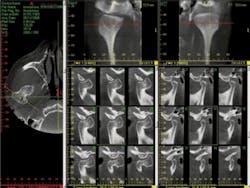10 tips from a trial lawyer
For more on this topic, go to www.dentaleconomics.com and search using the following key words: 3-D imaging, digital based, digital dentistry, legal, cone beam, Art Curley.
One of the most informative and intriguing talks I heard at the 1st International Congress on 3-D Dental Imaging was given by Art Curley, a practicing trial attorney in San Francisco. He is well versed in the dental field, with a law school roommate who studied dentistry and as a part of many court trials involving dentists. Following are nuggets from his lecture. Always verify any information with your local legal expert before employing it in your practice.
1) In today's courts in most states, claims are down but the verdicts from those awards are higher than ever. Today's courts are digital-based and juries welcome digital-based presentations from lawyers and trial participants.
2) Negligence is a violation of the standard of care in dentistry; standard of care is not static and moves very fast with the advent of new technology and techniques. Dental insurance can't dictate the standard of care. You have to discuss all reasonable options with patients, even if you know their insurance will not cover it. Of course, let them know their insurance won't cover a procedure, but you have to discuss it with them and give them the option to refuse.
3) It is almost malpractice to do implants in your practice without offering today's available technology, including 3-D imaging. Failure to employ technology can expose dentists to lawsuits. It is, in Mr. Curley's opinion, the standard of care to offer 3-D imaging for many implant patients where the potential of a better result would be increased.
4) Your office's health history form should be updated every year to reflect new concerns. For example, on every health history form, you should be asking your patients, “Have you ever taken bisphosphonates?” For medical conditions of concern, get and document medical consultations. One way to do that is the use of a “confirming fax” letter from the patient's physician.
5) Sending confirmation of a conversation to someone by fax is viewed as similar to sending something by certified mail. A fax can't be refused by the recipient and, if they don't respond to you, it is viewed as admission by silence by most courts. Also, you don't have to worry about a fax causing you to become HIPAA qualified. It is viewed as a phone call.
6) When using computer graphics for treatment presentations, you need to tell your patients that any computer-simulated “after” shots are estimates of how someone will look, not guarantees.
7) If something is in writing in a patient's chart, it gives the dentist more credibility in court. Keep good records in a patient's chart. In the chart, make sure you notate “RB&A discussed” — risks, benefits, and alternatives — after you talk to a patient about his or her options.
8) “Informed refusal” is one of the new hot topics. It simply means that the patient must acknowledge that he or she has been advised of the risks associated with refusing a recommended procedure.
9) Dentists and team members are not licensed to treat medical problems or any other issues outside of the oral cavity, so they are also not licensed to diagnose conditions outside the oral cavity that are outside the scope of their dental practice. Therefore, dentists can recommend 3-D imaging as an option withour fears that they could be liable for diagnosing everything seen on the image. They are only responsible for those areas that are within the scope of their practice, dentistry — jaws and oral cavity.
10) Blood pressure and pulse should be taken on every patient before every definitive procedure. This standard is designed to give dentists advance notice of conditions that may be aggravated by dental treatment, and give dentists the opportunity to get and document medical clearance.
Conclusion: In light of the rapid improvements in digital dentistry, dentists must keep current with evolving technologies, techniques, and continuing education.This includes the legal ramifications associated with these changes.
Following the success of the 1st International Congress on 3-D Dental Imaging, ISI will again assemble industry leaders, experts, and dental professionals to discuss 3-D dental imaging. Art Curley will be one of the featured speakers again this year.
The two-day symposium on the latest advances using 3-D Cone Beam technology will be a multidisciplinary seminar for all dental professionals. The symposium will offer lecture, as well as workshop opportunities. Workshops will be discipline specific.
There will also be separate courses designed specifically for hygienists and assistants on how to present treatment options to patients.
For more information on the agenda, speakers, and to register, visit www.i-cat3D.com.
For more on this topic, go to www.dentaleconomics.com and search using the following key words: 3-D imaging, digital based, digital dentistry, legal, cone beam, Art Curley.

